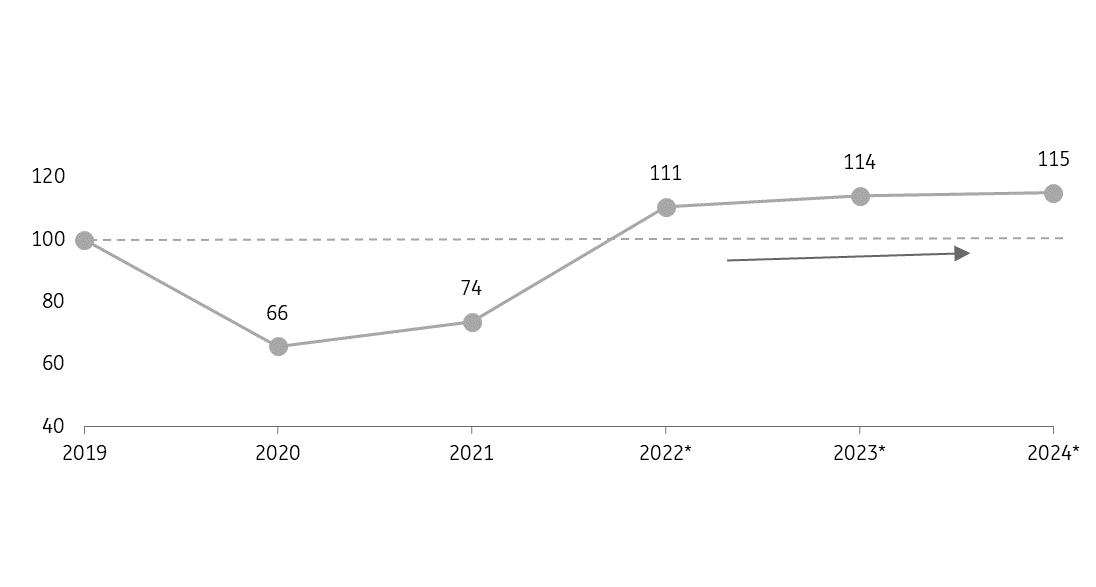A challenging year ahead for Dutch hospitality
Spending per restaurant visit is on the rise in the Netherlands, despite consumer confidence remaining subdued. We still think there's reason to remain cautious as hotel and restaurant entrepreneurs battle against high purchasing, personnel and energy costs along with persistent staff shortages
A return to stable growth for Dutch hospitality
Growth expectations for the hospitality industry in 2023 and 2024 are looking fairly positive. After the major catch-up last year, we expect volume growth of approximately 3% for 2023. This is, in part, a recovery from the Covid-19 pandemic – after all, the hospitality industry in the Netherlands was still facing restrictions in the first two months of 2022.
Now that almost all travel restrictions have been lifted worldwide, the number of foreign tourists visiting the Netherlands is also expected to increase this year. For 2024, we expect a minimum volume growth of around 1%, due partly to lower economic growth and a slight rise in unemployment.
After three turbulent years, the hospitality industry will return to a more stable growth path in 2023
Volume growth in the hospitality industry in the Netherlands, index 2019=100

Spending per restaurant visit begins to climb
Despite a strong start earlier this year, times are still challenging for the hospitality industry. Relatively high inflation resulted in historically low consumer confidence at the end of 2022, and although we saw some improvement in the first quarter of 2023, levels remained subdued.
So far, the hospitality industry has not particularly been affected. Consumers continue to spend in the hotel and restaurant sector for the time being, thanks in part to the extensive financial support package from the government for households and higher (minimum) wages. The most recent ING transaction data shows that on average, consumers spent about 7% more per restaurant visit in the first quarter of 2023 compared to the previous year.
The number of debit card transactions in restaurants and cafés, on the other hand, has remained relatively flat since the second quarter of last year. The number of cash transactions in March and April this year, for example, was almost identical to the same period a year earlier.
Prices expected to increase by an average of 4%
The relatively high inflation rate also weighs heavily on the hospitality industry. Six out of ten hotel and restaurant entrepreneurs report food, beverage, energy and personnel price increases that are worrying for the company, according to figures from CBS, a Dutch statistics agency.
As with many other sectors, the hospitality industry is not immune to the need to hike prices. This is often necessary to partly offset higher energy, purchasing and personnel costs. While energy costs are falling, personnel costs are rising due to wage increases. Restaurants and cafés will have to raise their prices further this year as a result, and we're expecting to see an average increase of 4%.
4% price increase estimated for restaurants and cafés in 2023
Consumer price index (cpi derived) for restaurants and cafés

Higher prices not entirely on the guest's plate
It's not always possible for the hospitality industry to pass on the higher energy, purchasing and personnel costs to customers in full – just one in three hotel and restaurant entrepreneurs are able to do so. This is significantly lower than in other sectors, as restaurants and cafés in particular struggle to put the prices completely at the customer’s expense. After all, if the price of a beer or a meal becomes too high, customers simply consume less or even stay away. Hotels are slightly less price sensitive in this area and can pass on the higher costs slightly more easily to their guests.
More business closures ahead 2023
For hotel and restaurant entrepreneurs who can only partially charge higher costs to customers, the remainder is often charged to the profit margin. Pressure has been applied for some time now – especially on restaurants and cafés – as a result of stronger competition in recent years, brought on by significant growth seen in the number of catering establishments. On top of that came the mandatory closures during the pandemic, which further eroded profit margins (especially in 2020).
Now that the time has come for hospitality companies to repay their tax debts accumulated during the pandemic, financial problems could be on the horizon. It's therefore expected that the number of business closures and bankruptcies in the hospitality industry will be significantly higher this year than in 2022.
Download
Download articleThis publication has been prepared by ING solely for information purposes irrespective of a particular user's means, financial situation or investment objectives. The information does not constitute investment recommendation, and nor is it investment, legal or tax advice or an offer or solicitation to purchase or sell any financial instrument. Read more
